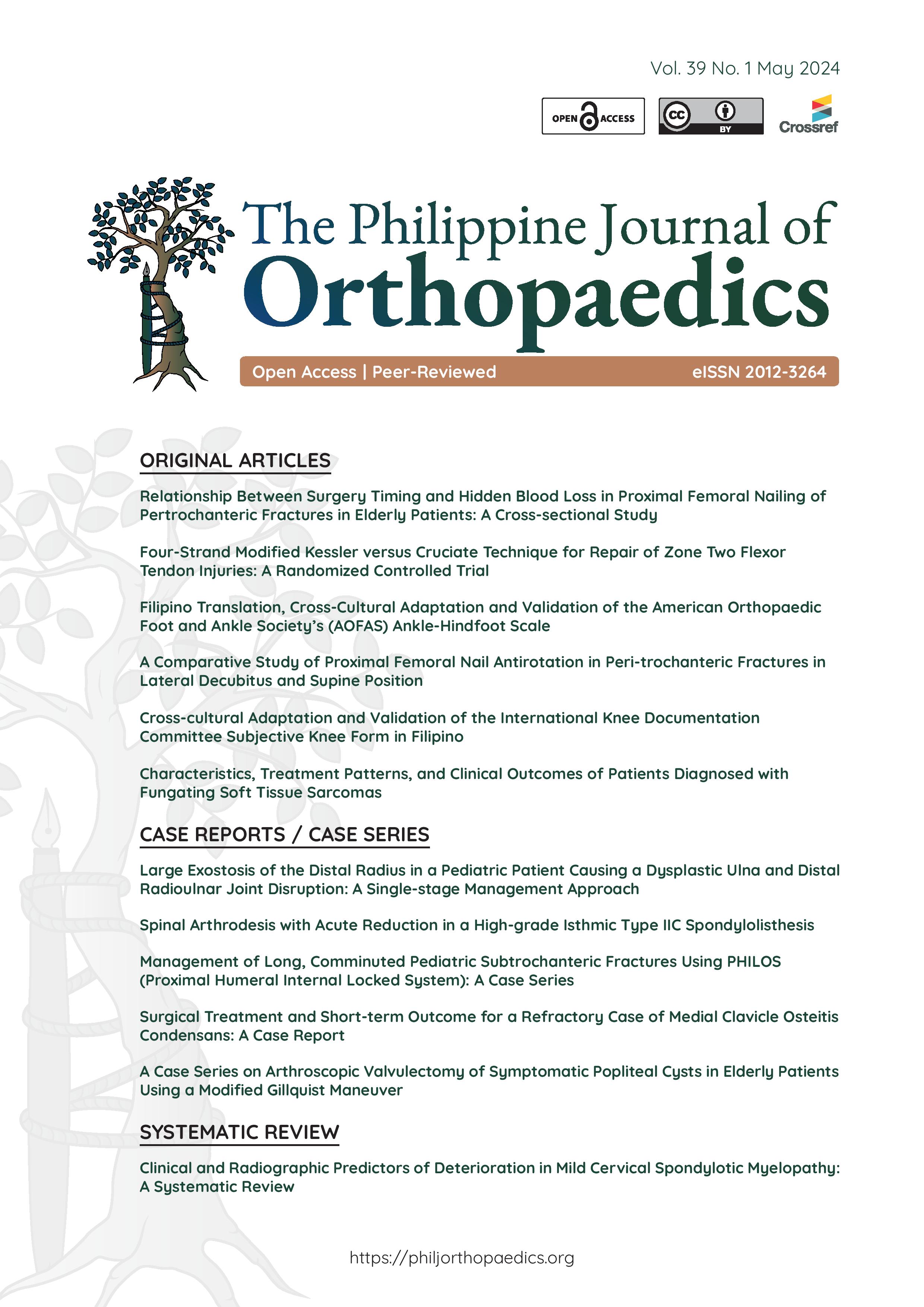Four-Strand Modified Kessler versus Cruciate Technique for Repair of Zone Two Flexor Tendon Injuries A Randomized Controlled Trial
Main Article Content
Abstract
Background. This is the first double-blinded randomized study in which the four-strand modified Kessler and the four-strand cruciate technique were compared in a series of zone II flexor tendon injuries in patients of working age (19–60 years old).
Objective. To compare the functional outcomes of zone II flexor tendon repair with the four-core modified Kessler versus the four-core cruciate technique done at our institution’s Hand Clinic.
Methodology. This double-blinded randomized controlled trial was conducted from September 2022 to August 2023. The sample population consisted of eight fingers of eight patients who sustained traumatic zone II flexor tendon lacerations. Statistical analysis was made between the functional outcomes using the Strickland formula at the fourth, sixth, and eighth weeks, and the FIL-DASH (Disabilities of the Arm, Shoulder, and Hand - Filipino translation) score at the third, and sixth months postoperatively.
Result. At weeks four, six and eight post-operatively, Strickland scores in the four-strand cruciate group were significantly higher than those in the four-strand modified Kessler group (p <0.02, p <0.03 and p <0.02). FIL-DASH
scores at three and six months did not differ significantly between the groups.
Conclusion. The four-core cruciate technique resulted in significantly better short-term functional outcomes than the four-core modified Kessler technique. More studies are needed to improve on these findings.
Article Details

This work is licensed under a Creative Commons Attribution 4.0 International License.

This work is licensed under a Creative Commons Attribution 4.0 International License.
References
Yuen MH, Ip WY. Tensile strength of modified 4-strand cruciate technique for transversely or obliquely lacerated tendons. J Orthop Surg (Hong Kong). 2007;15(1):27–31. https://pubmed.ncbi.nlm.nih.gov/17429113 https://doi.org/10.1177/230949900701500107
Ahmad M, Hussain SS, Tariq F, Rafiq Z, Khan MI, Malik SA. Flexor tendon injuries of hand: experience at Pakistan Institute of Medical Sciences, Islamabad, Pakistan. J Ayub Med Coll Abbottabad. 2007;19(1):6–9. https://pubmed.ncbi.nlm.nih.gov/17867470
Navali AM, Rouhani A. Zone 2 flexor tendon repair in young children: a comparative study of four-strand versus two-strand repair. J Hand Surg Eur Vol. 2008;33(4):424–9. https://pubmed.ncbi.nlm.nih.gov/18687828 Dhttps://doi.org/10.1177/1753193408090761
Kannus P, Józsa L, Jarvinnen M. Basic science of tendons. In: Garrett WE Jr, Speer KP, Kirkendall DT, editors. Principles and practice of orthopaedic sports medicine. Philadelphia: Lippincott Williams and Wilkins; 2000.
O'Brien M. Structure and metabolism of tendons. Scand J Med Sci Sports. 1997;7(2):55–61. https://pubmed.ncbi.nlm.nih.gov/9211604 https://doi.org/10.1111/j.1600-0838.1997.tb00119.x
Wu YF, Cao Y, Zhou YL, Tang JB. Biomechanical comparisons of four-strand tendon repairs with double-stranded sutures: effects of different locks and suture geometry. J Hand Surg Eur Vol. 2011;36(1):34–9. https://pubmed.ncbi.nlm.nih.gov/ 20682582 https://doi.org/10.1177/1753193410379554
Viinikainen A, Göransson H, Ryhänen J. Primary flexor tendon repair techniques. Scand J Surg. 2008;97(4):333–40. https://pubmed.ncbi.nlm.nih.gov/19211388 https://doi.org/10.1177/145749690809700410
Griffin M, Hindocha S, Jordan D, Saleh M, Khan W. An overview of the management of flexor tendon injuries. Open Orthop J. 2012;6:28–35. https://pubmed.ncbi.nlm.nih.gov/22431948 https://www.ncbi.nlm.nih.gov/pmc/articles/PMC3293389 https://doi.org/10.2174/1874325001206010028
Navali AM, Rouhani AR, Mortazavi MJ A comparative study of two suture configurations in zone II flexor tendon repair in adults. Acta Medica Iranica 2008;46(3):207–12.
Bhat W, Akhtar S. A further modification: the four-strand, single-knot, modified Kessler stitch. Plast Reconstr Surg. 2012;130(6):922e–3e. https://pubmed.ncbi.nlm.nih.gov/23190863 https://doi.org/10.1097/PRS.0b013e31826da1c7
McLarney E, Hoffman H, Wolfe SW. Biomechanical analysis of the cruciate four-strand flexor tendon repair. J Hand Surg Am. 1999;24(2):295–301. https://pubmed.ncbi.nlm.nih.gov/10194013 https://doi.org/10.1053/jhsu.1999.0295
Tang JB. Tendon injuries across the world: treatment. Injury. 2006;37(11):1036–42. https://pubmed.ncbi.nlm.nih.gov/17045267 https://doi.org/10.1016/j.injury.2006.07.027
Kleinert HE, Spokevicius S, Papas NH. History of flexor tendon repair. J Hand Surg Am. 1995 May;20(3 Pt 2):S46–52. https://pubmed.ncbi.nlm.nih.gov/7642949 https://doi.org/10.1016/s0363-5023(95)80169-3
Strickland JW. Flexor tendon injuries: I. Foundations of treatment. J Am Acad Orthop Surg. 1995;3(1):44–54. https://pubmed.ncbi.nlm.nih.gov/10790652 https://doi.org/10.5435/00124635-199501000-00006
Barrie KA, Tomak SL, Cholewicki J, Wolfe SW. The role of multiple strands and locking sutures on gap formation of flexor tendon repairs during cyclical loading. J Hand Surg Am. 2000;25(4):714–20. https://pubmed.ncbi.nlm.nih.gov/10913213 https://doi.org/10.1053/jhsu.2000.9414
Zeng W, Albano NJ, Sanchez RJ, et al. Beyond the core suture: a new approach to tendon repair. Plast Reconstr Surg Glob Open. 2020;8(12):e3280. https://pubmed.ncbi.nlm.nih.gov/33425594 https://www.ncbi.nlm.nih.gov/pmc/articles/PMC7787298 https://doi.org/10.1097/GOX.0000000000003280
Libberecht, K., Lafaire C, Hee R. Evaluation and functional assessment of flexor tendon repair in the hand. Acta Chir Belg. 2006;106(5):560–5. https://pubmed.ncbi.nlm.nih.gov/17168270 https://doi.org/10.1080/00015458.2006.11679952
Institute for Work and Health. Disabilities of the arm, shoulder and hand - Filipino translation (FIL-DASH); 2020. Accessed 05 May 2024. https://dash.iwh.on.ca.
Dawood AA. Repair of flexor tendon injuries by four strands cruciate technique versus two strands Kessler technique. J Clin Orthop Trauma. 2020;11(4):646–9. https://doi.org/10.1016/j.jcot.2020.05.038





